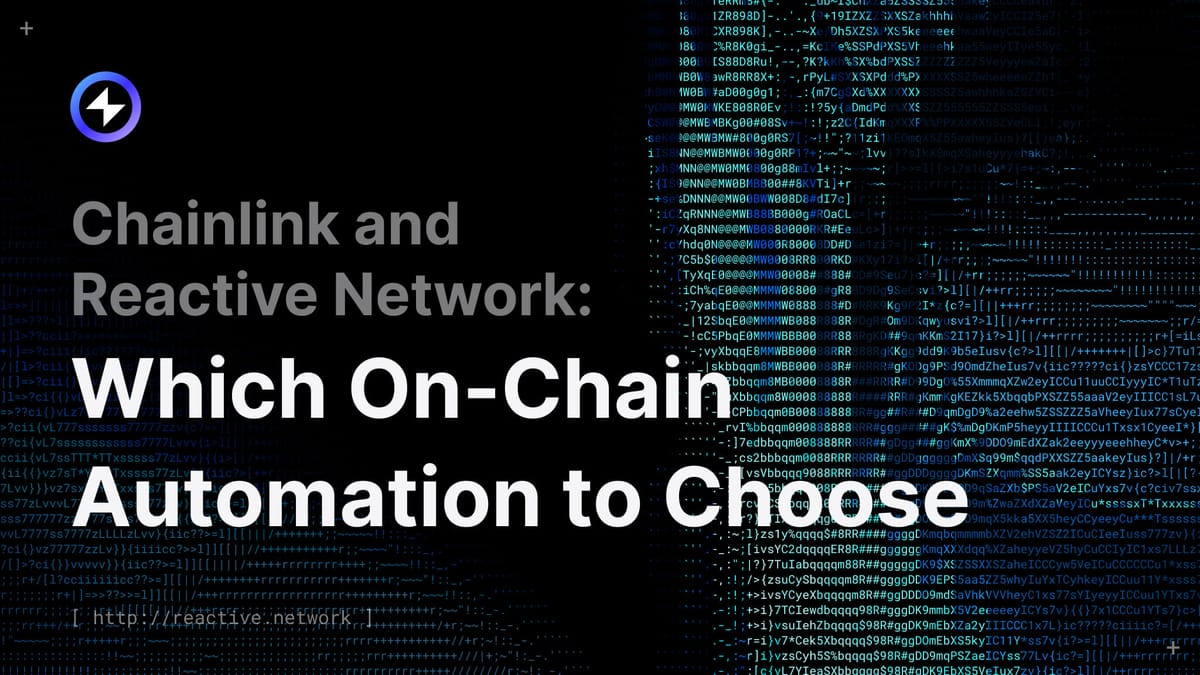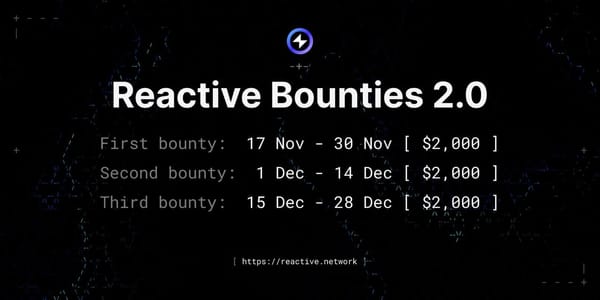Chainlink and Reactive Network: Which On-Chain Automation to Choose
This article compares Chainlink and Reactive Network, two leading blockchain platforms. Chainlink is known for its decentralized oracle services and off-chain automation, while Reactive Network offers a fully on-chain, developer-focused solution with seamless cross-chain functionality.

In the ever-evolving landscape of decentralized technology, both Chainlink and Reactive Network are key players, each bringing unique value to the blockchain ecosystem. While Chainlink has established itself as a leader, particularly in decentralized oracles, Reactive Network differentiates itself by providing a developer-centric, fully on-chain solution with deeper customization capabilities for autonomous execution. This article explores the similarities and differences between the two, focusing on their respective automation and cross-chain solutions.
Chainlink:
Chainlink is well-regarded for its decentralized oracle networks (DONs), which allow smart contracts to securely interact with off-chain data sources such as price feeds, sports scores, and external APIs. This infrastructure is essential for decentralized finance (DeFi) applications, where real-world data must be reliably injected into on-chain environments.
Chainlink’s automation solutions are built around event-driven triggers, relying on both off-chain data and on-chain events. Through its oracles, Chainlink automates tasks such as executing trades or rebalancing portfolios when certain conditions are met. However, a key point is that Chainlink’s system is heavily reliant on off-chain components, which are crucial for many automated actions. These dependencies can create potential bottlenecks in scenarios requiring low latency or minimal external coordination.
With Chainlink’s Cross-Chain Interoperability Protocol (CCIP), Chainlink enables the secure movement of tokens and data across blockchains. CCIP uses a Merkle root system, where messages are aggregated off-chain into a compact Merkle tree, then transmitted between chains. This minimizes gas fees while facilitating complex cross-chain decentralized applications (dApps). Developers can encode arbitrary data into these messages, making Chainlink adaptable for use cases involving cross-chain smart contract triggers and data transfers.
While this flexible architecture supports a wide range of dApp workflows, it can introduce complexity when developers need to manage highly specific or predefined contract logic. The reliance on arbitrary messaging and external infrastructure may not be ideal for real-time, high-precision applications, as the message-based approach can introduce latency or inefficiencies.
Reactive Network:
In contrast, Reactive Network is designed from the ground up as a business-to-developer (B2D) platform, prioritizing deep flexibility and complete on-chain operations. Our approach to automation and cross-chain functionality positions Reactive Network as a versatile, highly customizable infrastructure, suited for businesses that want fine-grained control over their smart contracts and decentralized applications.
One of the key differentiators of Reactive Network is its fully on-chain automation. Unlike Chainlink, where off-chain oracles and external systems play a crucial role, Reactive Network ensures that all automated processes are handled natively on-chain through Reactive Smart Contracts. These contracts are standard Ethereum smart contracts, which means developers can implement automation directly in Solidity, a language familiar to most in the blockchain space. This eliminates dependencies on external oracles for triggering events, making the system more secure and reliable for blockchain-native applications.
In terms of cross-chain operations, while Chainlink’s CCIP allows for token and data transfer across chains, Reactive Network offers a more seamless, cross-chain-native approach. Our cross-chain capabilities are built directly into the architecture of ReactVM, our virtual machine that handles state-aware smart contracts capable of interacting across multiple blockchains. This makes Reactive Network highly efficient for complex multi-chain operations, reducing the need for off-chain middleware or custom off-chain logic
Developer Experience:
For developers, the choice between Chainlink and Reactive Network depends on the nature of the application being built.
- Chainlink: Provides a highly flexible, generalized platform for developers building multi-chain dApps with varying use cases. Chainlink’s modular services (price feeds, automation, CCIP, randomness) can be combined to create powerful, diverse applications. However, setting up Chainlink’s Automation service requires developers to manage several external configurations, such as registering upkeeps and configuring parameters like gas limits, triggers, and ongoing LINK token funding. While this offers flexibility, it introduces complexity. Developers must ensure their upkeep contracts are continuously funded; otherwise, automation will pause, requiring manual intervention to restore operation.
- Reactive Network: Offers a familiar experience for developers through its Reactive Smart Contracts, which are standard Ethereum smart contracts. This universality allows developers to leverage existing knowledge without learning new frameworks. With Reactive Smart Contracts, you can implement if-this-then-that logic directly on-chain, creating powerful automated workflows without needing off-chain components. This brings efficiency to dApp development by keeping the reactive part fully on-chain, removing the reliance on off-chain triggers. Additionally, REACT token will be used to pay for transaction gas fees and event log processing fees within the Reactive Network.
Reactive Network also shortens the traditional development cycle significantly. In traditional systems, upgrading or fixing smart contracts can take months due to the complexities of off-chain and on-chain coordination. However, Reactive Network can reduce this time to weeks, saving both time and cost. Developers can focus on innovation rather than managing complex off-chain processes.
Looking ahead, Reactive Network is expanding beyond its current framework. We plan to extend support to additional EVM-compatible networks and even non-EVM networks in the future. This future-proof vision enables developers to think creatively about unique business cases that can be powered entirely on-chain, without worrying about off-chain dependencies. One of the standout features of Reactive Network is the ability to make event logs actionable and programmable entirely on-chain, making it ideal for use cases like governance, token buybacks, and automated payouts.
Conclusion
Choosing between Chainlink and Reactive Network ultimately depends on the specific needs of your decentralized application. Chainlink excels in flexible, generalized multi-chain operations but requires developers to manage external upkeep processes and off-chain components. On the other hand, Reactive Network offers a fully on-chain, developer-centric solution, streamlining automation and cross-chain interactions with minimal external dependencies. For businesses and developers seeking precise,real time, on-chain smart contract automation with complete control over execution, Reactive Network stands out as the ideal choice.
Join our Hackathon and bounty program today to start building with Reactive Smart Contracts and bring your innovative ideas to life on the Reactive Network!
About Reactive Network
The Reactive Network, pioneered by PARSIQ, ushers in a new wave of blockchain innovation through its Reactive Smart Contracts (RSCs). These advanced contracts can autonomously execute based on specific on-chain events, eliminating the need for off-chain computation and heralding a seamless cross-chain ecosystem vital for Web3’s growth.
Central to this breakthrough is the Inversion of Control (IoC) framework, which redefines smart contracts and decentralized applications (DApps) by imbuing them with unparalleled autonomy, efficiency, and interactivity. By marrying RSCs with IoC, Reactive Network is setting the stage for a transformative blockchain era, characterized by enhanced interoperability and the robust, user-friendly foundation Web3 demands.





